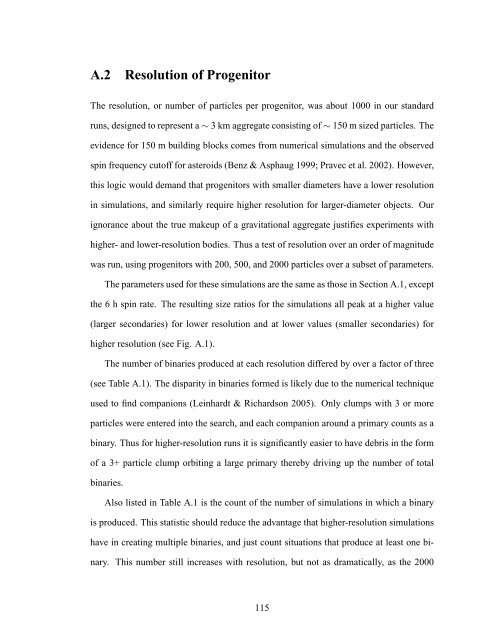Forming Binary Near-Earth Asteroids From Tidal Disruptions
Forming Binary Near-Earth Asteroids From Tidal Disruptions
Forming Binary Near-Earth Asteroids From Tidal Disruptions
Create successful ePaper yourself
Turn your PDF publications into a flip-book with our unique Google optimized e-Paper software.
A.2 Resolution of ProgenitorThe resolution, or number of particles per progenitor, was about 1000 in our standardruns, designed to represent a ∼ 3 km aggregate consisting of ∼ 150 m sized particles. Theevidence for 150 m building blocks comes from numerical simulations and the observedspin frequency cutoff for asteroids (Benz & Asphaug 1999; Pravec et al. 2002). However,this logic would demand that progenitors with smaller diameters have a lower resolutionin simulations, and similarly require higher resolution for larger-diameter objects. Ourignorance about the true makeup of a gravitational aggregate justifies experiments withhigher- and lower-resolution bodies. Thus a test of resolution over an order of magnitudewas run, using progenitors with 200, 500, and 2000 particles over a subset of parameters.The parameters used for these simulations are the same as those in Section A.1, exceptthe 6 h spin rate. The resulting size ratios for the simulations all peak at a higher value(larger secondaries) for lower resolution and at lower values (smaller secondaries) forhigher resolution (see Fig. A.1).The number of binaries produced at each resolution differed by over a factor of three(see Table A.1). The disparity in binaries formed is likely due to the numerical techniqueused to find companions (Leinhardt & Richardson 2005). Only clumps with 3 or moreparticles were entered into the search, and each companion around a primary counts as abinary. Thus for higher-resolution runs it is significantly easier to have debris in the formof a 3+ particle clump orbiting a large primary thereby driving up the number of totalbinaries.Also listed in Table A.1 is the count of the number of simulations in which a binaryis produced. This statistic should reduce the advantage that higher-resolution simulationshave in creating multiple binaries, and just count situations that produce at least one binary.This number still increases with resolution, but not as dramatically, as the 2000115












